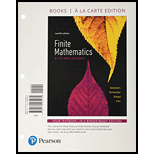
In Exercises 1–6, determine the next pivot element for the tableau.
Maximize
Trending nowThis is a popular solution!

Chapter 4 Solutions
FINITE MATHEMATICS & ITS APPLICATIONS
- 1. Show that, for any non-negative random variable X, EX+E+≥2, X E max X. 21.arrow_forwardFor each real-valued nonprincipal character x mod k, let A(n) = x(d) and F(x) = Σ : dn * Prove that F(x) = L(1,x) log x + O(1). narrow_forwardBy considering appropriate series expansions, e². e²²/2. e²³/3. .... = = 1 + x + x² + · ... when |x| < 1. By expanding each individual exponential term on the left-hand side the coefficient of x- 19 has the form and multiplying out, 1/19!1/19+r/s, where 19 does not divide s. Deduce that 18! 1 (mod 19).arrow_forwardProof: LN⎯⎯⎯⎯⎯LN¯ divides quadrilateral KLMN into two triangles. The sum of the angle measures in each triangle is ˚, so the sum of the angle measures for both triangles is ˚. So, m∠K+m∠L+m∠M+m∠N=m∠K+m∠L+m∠M+m∠N=˚. Because ∠K≅∠M∠K≅∠M and ∠N≅∠L, m∠K=m∠M∠N≅∠L, m∠K=m∠M and m∠N=m∠Lm∠N=m∠L by the definition of congruence. By the Substitution Property of Equality, m∠K+m∠L+m∠K+m∠L=m∠K+m∠L+m∠K+m∠L=°,°, so (m∠K)+ m∠K+ (m∠L)= m∠L= ˚. Dividing each side by gives m∠K+m∠L=m∠K+m∠L= °.°. The consecutive angles are supplementary, so KN⎯⎯⎯⎯⎯⎯∥LM⎯⎯⎯⎯⎯⎯KN¯∥LM¯ by the Converse of the Consecutive Interior Angles Theorem. Likewise, (m∠K)+m∠K+ (m∠N)=m∠N= ˚, or m∠K+m∠N=m∠K+m∠N= ˚. So these consecutive angles are supplementary and KL⎯⎯⎯⎯⎯∥NM⎯⎯⎯⎯⎯⎯KL¯∥NM¯ by the Converse of the Consecutive Interior Angles Theorem. Opposite sides are parallel, so quadrilateral KLMN is a parallelogram.arrow_forwardBy considering appropriate series expansions, ex · ex²/2 . ¸²³/³ . . .. = = 1 + x + x² +…… when |x| < 1. By expanding each individual exponential term on the left-hand side and multiplying out, show that the coefficient of x 19 has the form 1/19!+1/19+r/s, where 19 does not divide s.arrow_forwardLet 1 1 r 1+ + + 2 3 + = 823 823s Without calculating the left-hand side, prove that r = s (mod 823³).arrow_forwardFor each real-valued nonprincipal character X mod 16, verify that L(1,x) 0.arrow_forward*Construct a table of values for all the nonprincipal Dirichlet characters mod 16. Verify from your table that Σ x(3)=0 and Χ mod 16 Σ χ(11) = 0. x mod 16arrow_forwardFor each real-valued nonprincipal character x mod 16, verify that A(225) > 1. (Recall that A(n) = Σx(d).) d\narrow_forward24. Prove the following multiplicative property of the gcd: a k b h (ah, bk) = (a, b)(h, k)| \(a, b)' (h, k) \(a, b)' (h, k) In particular this shows that (ah, bk) = (a, k)(b, h) whenever (a, b) = (h, k) = 1.arrow_forward20. Let d = (826, 1890). Use the Euclidean algorithm to compute d, then express d as a linear combination of 826 and 1890.arrow_forwardLet 1 1+ + + + 2 3 1 r 823 823s Without calculating the left-hand side, Find one solution of the polynomial congruence 3x²+2x+100 = 0 (mod 343). Ts (mod 8233).arrow_forwardarrow_back_iosSEE MORE QUESTIONSarrow_forward_ios
 Linear Algebra: A Modern IntroductionAlgebraISBN:9781285463247Author:David PoolePublisher:Cengage Learning
Linear Algebra: A Modern IntroductionAlgebraISBN:9781285463247Author:David PoolePublisher:Cengage Learning Algebra for College StudentsAlgebraISBN:9781285195780Author:Jerome E. Kaufmann, Karen L. SchwittersPublisher:Cengage Learning
Algebra for College StudentsAlgebraISBN:9781285195780Author:Jerome E. Kaufmann, Karen L. SchwittersPublisher:Cengage Learning

